As usual, let's take a look at how different types of boats and hulls performed on this race to contribute to a better understanding of what makes a sailboat fast on an offshore race. This one has very little upwind sailing, it is almost all sailed downwind and beam reaching. I believe that it would be more interesting if the design of the route in between the Islands gave a more balanced sailing in what regards wind directions, but that's what it is, and here is well taken into consideration that gentlemen don't sail to windward. LOL
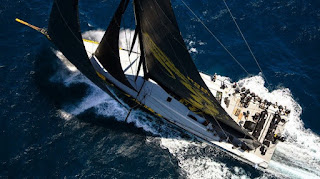 |
Skorpios, Swan 125 |
This time the big Russian Swan 125 Skorpios beat the Australian Comanche, gaining points as the fastest monohull, a title that for many years belonged to Comanche. The third was Leopard, but far away from these two, which have very similar performance, even if the Swan is considerably bigger.
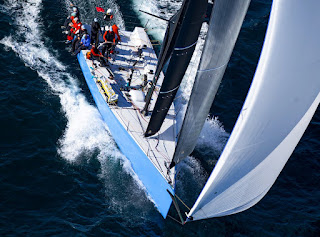 |
PAC 52 Warrior Won |
If we take into consideration the difference in size and the good TP52 performance in wind balanced races, like the Middle sea Race or the World ORC championship, it is easy to understand that this box rule gave origin to what is probably the fastest all-around type of hull, the one that you should take as a reference when trying to know how fast a performance cruiser is in real-time , or a cruiser-racer is.
"Warrior Won" is just a slightly modified TP52, with a bit more draft and a slightly bigger mast, and a 100kg lighter engine. In California, they tried to make a new class, the PAC 52, based on TP 52 hulls, but more turned to offshore racing. It seems that the class ended a short time after beginning and the links for the new class, and for the class' rules are no more online.
 |
PAC52 Warrior Won |
I believe the PAC52 class was not a good idea. Why a new class using the same hull, just for having boats that have very similar performances to TP52, that are also used in offshore races? It would make more sense to modify TP52 rule to allow for boats more suited, or comfortable, for offshore work, without diminishing the size or potential of one of the most successful one-class series, the TP52.
While the PAC52 as a one-class was a miss fire, the TP52 series continues successfully now with 23 yachts competing in this year's Super Series and many TP52 racing successfully in major IRC races or on the world ORC championship. Anyway, in what regards type and shape of the hull and ballast the differences are almost inexistent.
In this race, the PAC52 winner in IRC was not much slower than the VOR 65 and VOR 70 and that says how fast a TP 52 can be, taking into consideration the difference in size, and the fact they have not a canting keel, nor water ballasts, like the VOR65 or VOR 70.
 |
TS5/ORC50 Guyader Saveol |
Typically a TP52 has the maximum allowed beam, or close to it, and the max ballast (or close) and that means for a 15.85m boat, a 4.42m beam and a lead torpedo of 3800kg for a total displacement not lower than 6975kg. If all the others are close to the limit normally the average displacement is a bit bigger, around 7.5T, due to the difficulty of building a boat with the minimum displacement and the maximum ballast.
 |
Mylius 60 Lady First III, teak deck and all |
The ballast is needed to give a goop performance upwind and also beam reaching, without having a hull too beamy (more drag), one that would have a bad performance upwind. Even on the IMOCA, which are maximized for downwind racing and therefore beamier, to save weight in ballast at the cost of upwind performance, the B/D is around 38% but you have to take into account that the draft is much bigger than the one of a TP 52 (4.50m to 3.20m) and that the IMOCA have big liquid ballasts.
 |
Above, Mylius 60, below, Hanse 460 |
https://interestingsailboats.blogspot.com/2021/10/new-460-hanse-that-doesnt-look-like.html
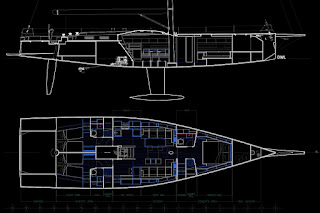 |
Mylius 60 CK |
Back to the race, the first cruiser-racers to arrive were the two mentioned cats, that were closely followed by the first monohull cruiser-racer, a Myliys 60, that contrary to the cats has a luxurious interior, beating the JP54, a more radical cruiser-racer with a canting keel and a beamier hull, more maximized for downwind sailing ( a kind of smaller MOCA adapted for cruising).
 |
Mylius 60 CK interior |
This Mylius 60 that was racing is not the fastest version, they have a new more powerful version with a canting keel (60 CK) and if this one is already a very fast sailboat we can only imagine the performance of the new one, that is already on the water and still with a luxurious interior, even if this time a lighter one. You can see it on the post cover.
 |
The first 40class racer, a Cape 40 |
https://interestingsailboats.blogspot.com/2021/07/mylius-50-carbon-rocket-cruiser-racer.html
Racing with very suitable conditions and wind direction, the Class 40 were very fast, especially the two first, also fast was the ICE 52, a performance cruiser that arrived close after the 3rd and 4th Class40. A post about the ICE 52 here:
https://interestingsailboats.blogspot.com/2016/12/the-ice-52-had-bad-luck-last-year-it.html
Super fast, were the two JPK 11.80, racing in conditions that would not suit them (compared to the 40class racers), the two first yachts with less than 40ft to arrive. They battled all the race long, winning Sunrise (the winner of Fastnet and the one that should have won the Middle Sea Race) by very little over Dawn Threader.
 |
ICE 52, above and below |
 |
Ice 52 interior |
It has an 11.80m HL, 3.95m beam (3.0 L/B), it is considerably heavier than the 40class (5950kg), having more ballast, but on a less efficient keel (2.34m draft), with a 44.4%B/D. The JPK 11.80 is probably today the best all-around IRC cruiser-racer of this size. An impressive performance here and even better on the Fastnet and on the Middle Sea Race (a winner in IRC on those).
 |
JPK 11.80 |
https://interestingsailboats.blogspot.com/2021/11/jpk-39-fast-cruiser-versus-jpk-1180.html
At this point many would want to know why the best 40Class racers are faster than the JPK 11.80, while the fastest Pogo 12.50 is much slower, even on a race that suits it (and not the JPK), and why is it possible to a J122e to have almost the same performance as a Pogo 12.50 when Pogo has a 40class hull (literally).
The Pogo 12.50 hull is from one of the previous Pogo 40class racers, but the main difference is the lack of 750L water ballast, 1000kg more displacement, and even if with about the same ballast (2000kg), a much less effective one, due to a big difference in draft, 2.2m to 3.0m (with similar type keels). The extra displacement gives it a smaller 36.4%B/D (about 44% on a class 40), but that difference would be much bigger if the two boats had the same draft.
 |
JPK 11.80 interior |
What makes it possible for a Class 40 to be a ton lighter than a Pogo 12.50 has to do with the boat typology: Class 40 is a racer, with racing accommodations, the Pogo 12.50 is a cruiser-racer with a cruising interior and in this similar to the JPK 11.80 and the J122e, even if regarding those cruising accommodations there are differences in quality and cruising suitability, being the ones from the Pogo and JPK comparable (even if very distinct) and those of the J122e of better quality and probably heavier.
 |
Pogo 12.50 Hermes |
While a Class 40 is designed to have the best performance on trade winds, the JPK 10.80 is designed to have a more balanced wind performance, with a good performance on the trade winds, but a better performance in races with a similar balance between upwind, beam reaching and downwind sailing and also designed to perform well in IRC or ORC racing.
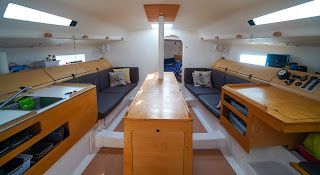 |
Pogo 12.50 interior |
So, how is this possible?: The J122e, a heavier sailboat, with a not very different B/D, with a lot less form stability, in a race with very little upwind sailing, to have almost the same performance as a Pogo 12.50, and worse than the one of a JPK 11.80? Well, it could happen that the Pogos were badly sailed, but if some excuse can be found for the 2nd one (2hand sailed), the first one was Hermes, a sailboat that is extensively raced (has a racing backstay) and has a good crew.
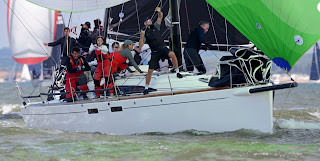 |
Juno, the fastest J122e in a coastal race |
I would love to see the J122e slightly modified, with a 2.50m draft and a torpedo keel, with the same ballast, a slightly more modern bow to increase LWL and a slightly modified stern that maintained the present hull characteristics but increase substantially hull form stability with stronger winds and at a heel angle just over 20º, or so.
 |
J122e interior |
However, I don't want to give the idea that narrowboats, like the J122e are the best solution for overall fast boats. The JPK 11.80 and the TP52 are much beamier. I have talked about the importance of the Drag/Power relation, but it does not tell the whole story and that is why the old America's Cup monohull, very narrow with a huge ballast and draft was not the fastest of the monohulls with that size.
Hull design, besides drag, has importance in what regards the easiness a boat can plan downwind and the wind speed that is needed for that to happen, and narrowboats go too deep in the water to make that happen easily. So the ability to plan (or foil) is another factor, but one that many times have been overvalued, but that it is a real one. Many have also the wrong idea that boats like Pogo are planing boats and that boats like the JPK 10.10/10.30 or the J122e are not and that is not true even if the wind needed is slightly less on the Pogo type of sailboats.
Look for instance at the Ocean Race Europe, where the old VOR65 beat clearly all the newer IMOCA in a race with mixed wings. I believe it will not be the case in the Circumnavigation race where more strong and downwind winds will be met. In the video below you can look at how different types of hulls plan, including the J122 that won that race overall (IRC).
 |
Jangada, JPK 10.10 |
A word for the 2 handed race, that here, contrary to Europe, does not have many adepts. There were only two boats racing, the JPK 10.10 and the 2nd Pogo 12.50. Both finished (congratulations), the Pogo without surprise was faster on the water, and the smaller JPK 10.10, was faster in handicap.
 |
JPK 10.30 |
https://interestingsailboats.blogspot.com/2020/02/on-rise-duo-and-solo-offshore-amateur.html
https://interestingsailboats.blogspot.com/2019/09/dehler-30-od-and-jpk-1030-first-movies.html
https://interestingsailboats.blogspot.com/2019/01/j99-versus-jpk1030.html
https://interestingsailboats.blogspot.com/2019/10/sun-fast-3300-beautiful-and-fast.html
Jangada, Richard Palmer JPK 10.10, with already some years (the current model is the JPK 10.30) sailed always in duo, has already a big racing pedigree having not only won many times the 2handed class, but overall the 2019 RORC Transatlantic Race. Below, on this year's race where it won the 2handed class.
And a final request: this type of posts are less popular on the media but give me much more work and time. Many asked me about a way to contribute to support my work, but I have opted for not to do it. However, if you like the post I ask you to click on the ads because only when somebody clicks them do I receive some cents. On this one and in other posts you like. I would appreciate that and you would contribute to the continuity of this blog.





Big fan of these type of posts. You help put all the pieces together from the boat specific descriptions!
ReplyDeleteGreat article. Many thanks!
ReplyDelete